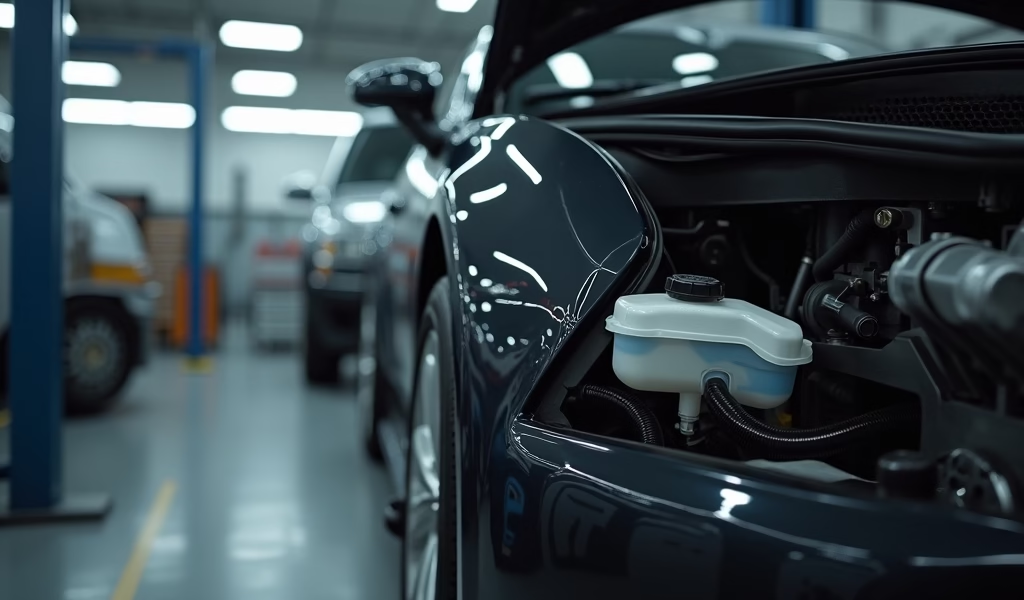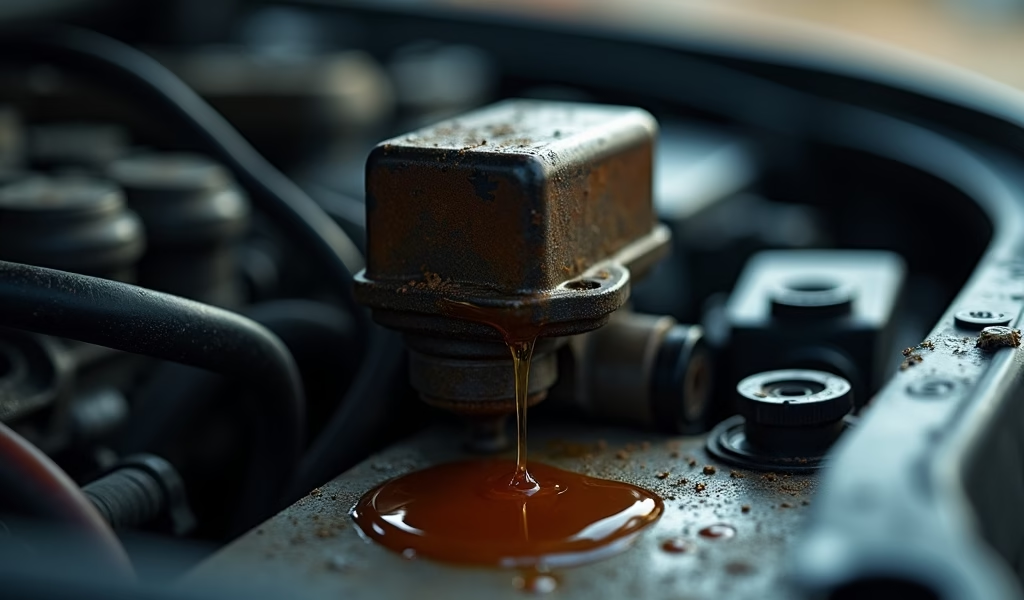Overview
This article explains master cylinder reservoir capacity issues in vehicle braking systems, covering signs of problems, measurement techniques, DIY upgrades, and professional solutions. It emphasizes the critical safety importance of maintaining proper reservoir capacity, especially after brake modifications, and provides maintenance tips to prevent future issues.
Table of Contents
- Understanding the Master Cylinder Reservoir
- Signs of Master Cylinder Reservoir Capacity Issues
- Measuring and Determining Proper Capacity
- Common Master Cylinder Reservoir Capacity Fixes
- DIY Master Cylinder Reservoir Capacity Upgrades
- Professional Solutions for Reservoir Capacity Problems
- Maintenance Tips to Prevent Future Issues
- Conclusion
- Frequently Asked Questions
Understanding the Master Cylinder Reservoir
The master cylinder reservoir capacity is a critical component of your vehicle’s braking system that often doesn’t get the attention it deserves. Think of it as the heart of your brake system—it stores and supplies the brake fluid that makes your entire braking system work. Without adequate capacity, your brakes could fail when you need them most. 🔧
Most modern vehicles use a dual-reservoir master cylinder system, which separates the front and rear brake circuits. This design is a safety feature that ensures if one circuit fails, you’ll still have partial braking power. The reservoir needs to maintain enough fluid to accommodate the movement of brake pistons and compensate for pad wear over time.
The standard reservoir capacity varies by vehicle type and braking system design. Typically, passenger cars have smaller reservoirs (about 500ml), while larger vehicles like trucks might have capacities of 1 liter or more. When properly filled, the fluid level should be between the “MIN” and “MAX” markings on the reservoir.
Brake systems rely on hydraulic pressure to function, and that pressure can only be maintained with adequate fluid. When you bleed your brake master cylinder properly, you’re ensuring no air is trapped in the system—but you also need sufficient reservoir capacity to accommodate this process.
Signs of Master Cylinder Reservoir Capacity Issues
Recognizing when your master cylinder reservoir is experiencing capacity problems can save you from dangerous driving situations. Let’s examine the warning signs that shouldn’t be ignored.
The most obvious indicator is frequent low fluid levels despite regular top-offs. If you’re adding brake fluid every few weeks when it should last months, something’s not right. This could indicate either a leak or insufficient capacity for your vehicle’s needs.
A spongy brake pedal that gradually sinks to the floor is another telltale sign. This occurs when air enters the system because the reservoir can’t maintain proper fluid levels during braking operations. You might also notice decreased braking performance, especially during extended downhill driving or repeated hard stops.
Visual inspection can reveal problems too. Look for fluid that consistently drops below the “MIN” line or for a reservoir that appears strained or bulging. Some drivers might also notice brake fluid warning lights on the dashboard or hear unusual hissing or bubbling sounds from the reservoir area during braking.
Pay attention to brake performance changes after modifications. If you’ve upgraded to larger calipers or added a performance brake kit, your stock reservoir might no longer have adequate capacity for the increased fluid demands of your enhanced system.

Measuring and Determining Proper Capacity
Figuring out the right master cylinder reservoir capacity for your specific vehicle isn’t guesswork—it’s a calculated decision. Let’s break down how to accurately measure and determine what your system needs.
Start by consulting your vehicle’s service manual for the manufacturer’s specifications. These specifications are based on extensive testing and represent the minimum capacity needed for safe operation. For most passenger vehicles, the standard capacity ranges from 400-600ml, while performance or heavy-duty applications might require more.
To measure your current capacity, you’ll need to drain the system properly. Place a measuring container beneath the bleeder valves, then open them one at a time while having an assistant pump the brakes. Collect and measure all fluid to determine your system’s total volume. Remember to account for the fluid that remains in the lines and calipers—typically about 50-100ml.
The proper capacity calculation should include a safety margin. As a rule of thumb, your reservoir should be able to hold at least 150% of your total system fluid volume. This accounts for fluid expansion due to heat and compensates for pad wear over time. The Federal Motor Carrier Safety Administration provides guidelines that manufacturers must follow regarding brake system capacity requirements.
If you’ve modified your braking system with larger calipers or additional brake components, you’ll need to recalculate. Each additional millimeter of caliper piston diameter can significantly increase fluid requirements. Performance setups with six-piston calipers, for example, may require nearly double the reservoir capacity of standard two-piston systems.
Common Master Cylinder Reservoir Capacity Fixes
When your master cylinder reservoir isn’t cutting it capacity-wise, you’ve got several practical solutions available. Let’s explore the most effective fixes that will keep your braking system operating safely.
The simplest solution is installing a larger OEM reservoir. Many manufacturers offer different sizes for various models in their lineup, and often these can be swapped directly. Check compatibility with your master cylinder bore size before purchasing to ensure proper fit and function.
Aftermarket expansion reservoirs provide another excellent option. These supplemental containers connect to your existing reservoir via brake-safe tubing and effectively increase your system’s capacity. Installation typically involves drilling and tapping into your current reservoir and routing the connection line to the new expansion tank.
Consider these specific capacity upgrades for common vehicles:
- For trucks and SUVs: Wilwood’s remote reservoir kits add 250-500ml capacity
- For performance cars: Brembo and StopTech offer integrated larger capacity units
- For classic vehicles: Universal remote reservoirs from Summit Racing or Jegs can be adapted
If you’re dealing with a completely inadequate original design, a master cylinder replacement might be your best bet. Modern replacement units often feature improved capacity over older designs while maintaining proper bore sizing and pedal feel. Make sure to select one with the correct bore diameter for your vehicle’s braking requirements and the proper brake fluid DOT specification compatibility.
For serious performance applications, a complete brake system overhaul with a properly sized dual master cylinder setup might be warranted. This approach allows you to perfectly balance front/rear braking forces while ensuring adequate fluid capacity for high-demand driving situations.
DIY Master Cylinder Reservoir Capacity Upgrades
Rolling up your sleeves to tackle a master cylinder reservoir capacity upgrade can be both satisfying and cost-effective. With the right approach, these DIY solutions can be implemented in your garage over a weekend. 🛠️
The most straightforward DIY upgrade involves installing an auxiliary reservoir. You’ll need to purchase a universal brake fluid reservoir kit (available from brands like Russell or Earl’s), high-pressure brake line, and appropriate fittings. Carefully drill and tap your existing reservoir cap, install a bulkhead fitting, and connect the auxiliary reservoir at a higher position than your master cylinder to maintain proper gravity feed.
For plastic reservoir upgrades, consider these steps:
- Remove the original reservoir from the master cylinder
- Clean all sealing surfaces thoroughly
- Install the new larger capacity reservoir using new gaskets
- Test for leaks before road testing
If you’re feeling adventurous, you might fabricate a custom reservoir extension. Using brake-fluid-compatible materials (aluminum is ideal), you can create an extension that raises the height of your existing reservoir. This requires precise measurement and potentially some machining skills, but can provide a clean, integrated look. The Specialty Equipment Market Association offers guidelines for fabricating brake system components that meet safety standards.
Whatever DIY route you choose, safety is paramount. Always use new, clean brake fluid of the correct type, and thoroughly bleed the entire system after any reservoir modifications. Test extensively in a safe environment before returning to regular driving.

Professional Solutions for Reservoir Capacity Problems
Sometimes, the safest and most effective approach to master cylinder reservoir capacity issues is consulting with professionals. Let’s look at when and why professional assistance makes sense.
Performance brake specialists have extensive experience sizing systems correctly for specific applications. These experts can evaluate your entire braking system, factoring in vehicle weight, driving style, and modifications to recommend the optimal reservoir capacity. A professional shop might suggest integrated solutions that aren’t obvious to DIY mechanics.
Custom fabrication services offer another professional route. Shops specializing in brake system modifications can create custom reservoirs tailored to your specific space constraints and capacity requirements. These custom solutions often provide better integration with your existing components than universal add-ons.
Race prep shops offer comprehensive brake system packages that include properly sized reservoirs. If you’re building a performance or track vehicle, these packages ensure all components are matched for optimal performance and safety. According to Car and Driver’s brake system analysis, integrated systems designed by professionals typically outperform piecemeal upgrades in both performance and reliability.
When considering professional services, expect to pay between $300-800 for standard capacity upgrades and potentially more for custom solutions. While this exceeds the cost of DIY options, the assurance of proper design, installation, and system integration often justifies the expense for critical safety systems like brakes.
Maintenance Tips to Prevent Future Issues
Maintaining your master cylinder reservoir properly can prevent capacity issues from developing in the first place. Let’s explore some practical maintenance strategies that will keep your braking system healthy.
Regular inspection is your first line of defense. Check your brake fluid level at least monthly, ensuring it remains between the MIN and MAX marks. The fluid should be clear to amber in color—dark brown or black fluid indicates contamination and requires immediate replacement.
Follow a strict fluid change schedule based on your vehicle manufacturer’s recommendations—typically every 2-3 years regardless of mileage. Fresh fluid maintains proper viscosity and prevents corrosion within the system, which can affect reservoir capacity and function.
Here’s a simple maintenance routine to follow:
- Inspect reservoir monthly for cracks, bulging, or discoloration
- Clean the exterior and cap area before opening to prevent contamination
- Replace reservoir cap seals at each fluid change
- Test brake pedal feel regularly to catch early signs of capacity issues
Consider installing a transparent aftermarket reservoir cap or sight glass if your vehicle lacks one. This simple modification makes monitoring fluid levels much easier and encourages regular checking. Some performance caps even include built-in fluid temperature indicators, providing additional data about your system’s condition.
Finally, be proactive about brake pad wear. As pads wear, caliper pistons extend further, drawing more fluid from the reservoir. Replacing pads before they become extremely thin helps maintain adequate reservoir capacity and system performance.
Conclusion
Addressing master cylinder reservoir capacity issues is more than just a mechanical fix—it’s an investment in your vehicle’s safety and performance. Whether you’re experiencing symptoms of inadequate capacity or planning ahead for brake system modifications, understanding the importance of proper reservoir sizing is crucial.
We’ve covered everything from identifying capacity problems to implementing both DIY and professional solutions. Remember that your braking system is only as effective as its weakest component, and an undersized reservoir can compromise even the most expensive brake upgrades.
For standard daily drivers, simple reservoir replacements or auxiliary tanks often provide sufficient capacity improvements. Performance vehicles and those with significant brake modifications may require more comprehensive solutions, including custom fabrication or complete master cylinder upgrades.
Whatever approach you choose, prioritize safety through proper bleeding, testing, and regular maintenance. Your brake system is your vehicle’s most important safety feature—give it the attention and care it deserves by ensuring your master cylinder reservoir capacity meets or exceeds your vehicle’s requirements.
Frequently Asked Questions
How do I know if my master cylinder reservoir capacity is too small?
Look for frequent low fluid levels, a spongy brake pedal, or decreased braking performance. These symptoms typically appear after brake modifications or when components wear beyond normal tolerances.
Can I just add a second reservoir to fix capacity issues?
Yes, adding an auxiliary reservoir is a valid solution that can effectively increase system capacity. Ensure it’s mounted higher than the master cylinder and connected with brake-safe tubing and fittings.
How often should I check my master cylinder reservoir level?
Check your brake fluid level at least monthly and before any long trips. Regular inspection helps catch capacity issues or leaks before they become safety hazards.
Does brake fluid type affect reservoir capacity requirements?
Brake fluid type doesn’t directly affect capacity requirements, but it does impact system performance. Always use the manufacturer-recommended DOT specification fluid for your vehicle.
Will upgrading to larger brakes always require a larger reservoir?
In most cases, yes. Larger calipers, additional pistons, or multi-caliper setups require more fluid volume to operate properly, necessitating increased reservoir capacity.

